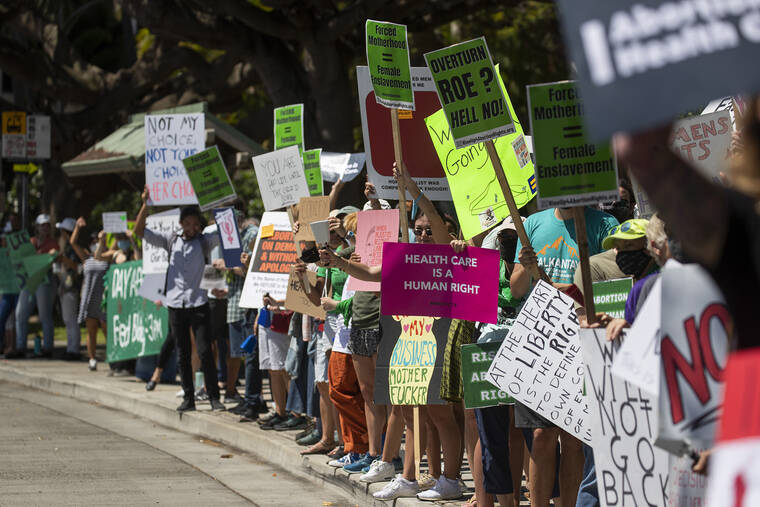Something that had been expected for weeks was still a shock when it actually happened — especially in Hawaii, where abortion became legal in 1970, a full three years before Roe v. Wade made access to the procedure a federal right.
Anticipation that had simmered for weeks since the leak of an early draft of the final decision boiled over on Friday, when the final, 6-3 majority opinion of the U.S. Supreme Court was released.
The grievous decision to strike down the 50-year-old precedent — ending a critical health-care choice that two generations of the nation’s women have assumed was theirs to make — set off protests around the country. There were rallies and demonstrations here as well, even though the ruling essentially leaves abortion rights up to each state.
Hawaii’s childbearing women are unlikely to see their reality altered. Abortion rights almost certainly will remain in place here for the foreseeable future; the correct impulse now under discussion would be to find a way to strengthen them. Reactions from state and congressional officials here were uniformly supportive of abortion rights.
But reproductive rights will be up-ended in numerous other states, where “trigger” laws were set to ban abortion the instant the standards set by Roe v. Wade and Planned Parenthood v. Casey were dismantled. Those two key decisions combined to establish that states could not prohibit abortion before the point at which a fetus could survive outside the womb — about 23 weeks into a pregnancy.
Decades in which the conservative tilt of the Supreme Court was built up through strategic presidential appointments culminated with Friday’s ruling: in Dobbs v. Jackson Women’s Health Organization, the Mississippi case concerning a ban on abortion after 15 weeks. The question was whether the court would narrowly let that law stand, or use it to reverse Roe and Casey entirely.
It was the latter, in the end. The argument, as written by Justice Samuel Alito, was that a federal right to an abortion never had a constitutional basis to begin with. And opponents of abortion, jubilant about the ruling, maintain that leaving regulation of abortion to the states is the right way to handle this complex issue.
That is a hard assertion to support. It’s simply unjustifiable that one woman in Hawaii should have freedom to make such a personal, private and fundamental decision — which she should — while another in Texas, for example, should not, simply because of where they happen to live in this country or what politicians in their state decide.
Further, it’s important to note that the Dobbs ruling could have ripple effects on Hawaii. Yes, the majority Democrats in state government here have been staunch defenders of abortion rights. Abortion became law in March 1970 without the signature of Gov. John Burns, a devout Catholic who, nevertheless, rightly did not allow his personal beliefs to obstruct the free choice of Hawaii’s people.
But the contingent of those who consider themselves “pro-life” voters is larger than it once was. Now that Roe is gone, Hawaii can expect to hear the call for new abortion restrictions here to grow louder. Those who think a change in direction for this state is impossible should remember that few would have predicted the national overturning of a half-century of precedent until a few years ago.
Rights should not be taken for granted. As they should, local leaders already are considering ways to strengthen access to abortion, especially for lower-income women who should by law have the same uncurtailed health-care options. A constitutional amendment protecting rights deserves full discussion.
But legislators also can represent the interests of constituents who, just as passionately, see abortion as killing an unborn fetus. To make reproductive decisions a truly free choice, support should be given to programs that provide care prenatally and into early childhood for those who do opt for parenthood. Many of these also are poor women who lack sufficient means to have the baby.
Also, it would be prudent for the state to review access to contraception among adolescent girls and young women, in the hope that they wouldn’t have to make such a painful choice.
With good reason, many abortion rights advocates fear what actions the Supreme Court could take next. In his opinion, Alito made a distinction between abortion and other personal decisions people make because an unborn fetus is involved, and indicated that the same conclusions need not apply to issues such as contraception or marriage equality.
But Justice Clarence Thomas, in a concurrent opinion, wrote that the court could rethink these matters as well. This compounds the anxiety of those who fervently hope this is not the court’s unswerving ambition.
If the Supreme Court believes such issues should be a political decision by individual states, the nation just might see that play out this fall. Abortion is sure to factor heavily on many states’ ballots; in Hawaii, maybe not so much. But as Friday’s high court ruling shows, nothing is guaranteed, not even long-held rights. Hawaii citizens should put the question to candidates, and vote accordingly.

